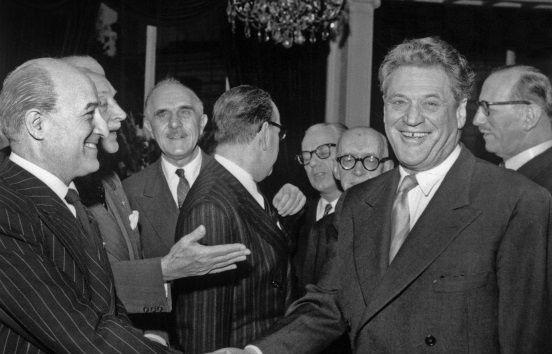Graduate of Classics, Stéphane Ratti is a professor at the University of Bourgogne-Franche-Comté.
The publication in the prestigious Bibliothèque de la Pléiade of two superb volumes dedicated to the novels of Joseph Kessel under the direction of Serge Linkès and of a very rich Album devoted by Gilles Heuré to the life of the writer should allow us to wonder about the reasons for the success of his best-known novel,
The Lion
.
Since its publication in 1958 this book has sold, all collections combined, nearly five million copies, and is regularly, according to the publisher Gallimard, its fourth best annual print.
Its author received a very personal letter of congratulations from General de Gaulle:
“My dear Joseph Kessel, The Lion is magnificent.
It is perhaps the most beautiful of your books… ”
The success for decades of this novel holds, as for
Les Racines du Ciel
by Romain Gary, published barely two years earlier in 1956, partly in the “ecological” ideal (the word did not exist at the time) that he seems to defend.
The age of the heroine, a ten-year-old girl, also helped make this title a staple, for years, of college programs.
The novel draws its strength from its construction towards a tragic outcome, announced, predicted, and understood as such, as it should be, by the reader.
But it would be very wrong to stop at these appearances.
The meaning of
Leo
is, indeed, much deeper.
Nothing childish in the love between the lion and the young heroine, nothing Edenic in the savannah where the action takes place, at the foot of Kilimanjaro, no kindness in the psychology of the characters, no morality on the part of Kessel and even less scholarly ethnography.
The novel draws its strength from its construction towards a tragic outcome, announced, predicted, and understood as such, as it should be, by the reader.
The family of the director of the Park, John Bullit, who welcomes the narrator, consists of a violent and savage father, a hysterical mother and the heroine Patricia, inhabited by a powerful Oedipus as the choice by the author of his first name, Patricia (de pater, the father in Latin), clearly lets it guess (Joseph Kessel's father had a doctorate in psychiatry and knew perfectly Latin and Greek).
We know in fact that the girl's love for her lion, King, is a sublimation of her amorous passion for her father, described by Kessel on several occasions as wearing the same tawny "fleece" as the lion (Kessel insists on his
"broad, almost animal face under the fleece of red hair"
, p. 994), giving her daughter the same caresses as this one with the lion, who, moreover, passes, in the legends peddled in the savannah, for the real father of Patricia.
The novel also sets itself the objective of analyzing the characters who, when they no longer roam the great outdoors and are locked in an enclosed space, tear each other apart.
It is a question, writes Kessel, of bringing to light
"the truth of the beings gathered under this roof: falsely asleep, dangerous, unhealthy waters"
(p. 1056).
To read also:
“Itinerary at dusk”: in the footsteps of Joseph Kessel
If we think about it, we see in the director of the Park, who is a converted poacher, like an entirely pagan guardian - the lion, unlike savage beauty, embodies heresy in the Christian tradition (in the Psalms ) or the devil (in Saint Augustine) - of places shaped
“in the last days of creation”
.
Bullit is a Hercules capable of wrestling with the lion King, like his model with that of Nemea;
Patricia speaks to animals like Orpheus the magician of mythology;
Sybil, her mother, is indeed a real sibyl, able to read the future
"with the keenest intelligence and the finest sensitivity"
, but no one believes her (
"They think that I am blind ..."
).
However, all of them have a vague idea, without succeeding in defining it, the final drama and, by dint of wanting to avoid it, facilitate its inexorable fulfillment.
Never, in this novel, he gives in to the traps of psychologizing introspection which he hated and designated as his own "people intellectualized to the extreme" which formed according to him "a dogmatic trap".
As in classic tragedy, fear, terror and pity seize the reader as they inhabit the parents of the heroine and the narrator.
So in this magnificent page, close to the denouement, where we see Kessel successively using all the words that define tragic theater according to Aristotle: cruelty, anger, terror, pity, sorrow, tenderness and, finally, fault (p. 1099) :
"Curtain after curtain, the earth opened its theater for the games of the day and of the world"
.
And Sybil, who has the thankless role of the prophetess, sees alone, in tremors characteristic of a Pythian trance, the terrible end, which allows her to affirm:
"It is not the fault of anyone"
, as in the
Oedipus
of Sophocles, where no one is guilty.
Only Patricia is spared because she ignores
"the meaning of death"
and for this reason remains
"without pity or fear"
until she understands that the destiny she had "
brought about, called, prepared by instinct stubborn and subtle ”
was in the process of being fulfilled (p. 1121): the double loss of the father and the lion.
The father kills the lion, sacrifices his double and by this act renounces the love of his daughter.
The sublime end of the novel reveals the power of Kessel's writing.
While the narrator opened in the opening page of the novel a new world thanks to a little monkey which lifts his eyelids (magnificent incipit reminiscent of that of
The Human Condition
:
"Did he pull on my eyelids to see what they were hiding? ”
), death for the lion is described as
“ a kind of vitrified veil (which) was beginning to cover (its) eyes ”
.
In front of the lion's corpse the heroine experiences fear for the first time and realizes that at least indirectly she is the cause of the death of her fantasized father, the lion:
“I was sworn,” says a character, that 'she has a lion as her father
,' thus satisfying an unavowable desire.
Kessel had written with
Le Tour du malheur
, very unjustly badly received by the critics a few years earlier, an epic of true magnitude, around a main character.
With
The Lion,
he organizes a drama with a fatal outcome around a handful of protagonists.
And then, in this novel, he never gives in to the traps of psychologizing introspection which he hated and designated as his own
"people intellectualized to the extreme"
which formed, according to him,
"a dogmatic, exclusive camp"
.
The supposed innocence of the early days of the world is only an illusion.
Murder and sacrifice offer a drop in the curtain bathed in blood.





/cloudfront-eu-central-1.images.arcpublishing.com/prisa/H7FOTEWU7BCBPGTXHO6TB6OI3I.jpg)


